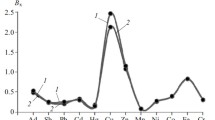Abstract
In an attempt to characterize inorganic constituents in Tuber aestivum, the summer truffle, samples from four different German states were collected by the “hypogea research group” for analytical investigations. Forty three elements in truffles, peridium and gleba were determined by three independent analytical techniques, PGAA, INAA and ICP-MS. PCA analysis of a set of data revealed a clear distinction of the different sampling sites. Results are discussed in view of the functional role of mycorrhizal fungi towards their host trees and the homeostatic control properties of the fungi.




Similar content being viewed by others
References
Wedén C, Danell E, Tibell L (2005) Species recognition in the truffle genus Tuber—the synonyms Tuber aestivum and Tuber uncinatum. Environ Microbiol 7:1535–1546
Eva Streiblová, Hana Gryndlerová, Valda S, Gryndler M (2010) Tuber aestivum—hypogeous fungus neglected in the Czech Republic. A review. Czech Mycol 61(2):163–173
Wikipedia https://en.wikipedia.org/wiki/Ascomycota. Assessed 2 Dec 2018
Büntgen U, Bagi I, Fekete O, Molinier V, Peter M, Splivallo R et al (2017) New Insights into the Complex relationship between Weight and Maturity of Burgundy Truffles (Tuber aestivum). PLoS ONE 12(1):e0170375. https://doi.org/10.1371/journal.pone.0170375
Matzke-Hajek G, Hofbauer N, Ludwig G (Red.) (2016) Rote Liste gefährdeter Tiere, Pflanzen und Pilze Deutschlands. Band 8: Pilze (Teil 1)—Großpilze.—Münster (Landwirtschaftsverlag).—Naturschutz und Biologische Vielfalt 70(8):440S. ISBN 978-3-7843-5454-5
Hilszczańska D, Siebyła M, Horak J et al (2010) Comparison of chemical composition in Tuber aestivum VITTAD. of different geographical origin. Chem Biodivers 13:1617–1629
Culleré L, Ferreira V, Chevret B et al (2010) Characterisation of aroma active compounds in black truffles (Tuber melanosporum) and summer truffles (Tuber aestivum) by gas chromatography-olfactometry. Food Chem 122(1):300–306
Kiss M, Csóka M, Györfi J, Korány K (2011) Comparison of the fragrance constituents of Tuber aestivum and Tuber brumale gathered in Hungary. J Appl Bot Food Qual 84:102–110
Rossbach M, Kümmerle E, Schmidt S et al (2017) Elemental analysis of Morchella esculenta from Germany. J Radioanal Nucl Chem 313(1):273–278
Polkowska-Motrenko H, Rossbach M (2007) Preparation and characterization of a proficiency test material “Polish mushrooms” supported by the International Atomic Energy Agency (IAEA), Vienna. Accred Qual Assur 12:343–350
Molnar G (ed.) (2004) Handbook of prompt gamma activation analysis: with neutron beams. Springer, Berlin. ISBN 9781402013041
Kudejova P, Révay Z, Kleszcz K, Genreith C, Rossbach M, Schwengner R, Zuber K (2015) High-flux PGAA for milligram-weight samples. In: EPJ Web of Conferences 93, S. 08002. https://doi.org/10.1051/epjconf/20159308002. ISSN 2100–014X
Zs Révay, Kudejová P, Kleszcz K, Söllradl S, Genreith C (2015) In-beam activation analysis facility at MLZ, Garching. Nucl Instr Method A 799:114–123
Fazekas B, Molnar G, Belgya T, Dabolczi L, Simonits A (1997) Introducing HYPERMET-PC for automatic analysis of complex gamma-ray spectra. J Radioanal Nucl Chem 215(2):271–277
Zsolt Révay (2009) Determining elemental composition using prompt gamma activation analysis. Anal Chem 81(16):6851–6859
Samczyński Z, Dybczyński RS, Polkowska-Motrenko H, Chajduk E, Pyszynska M, Danko B, Czerska E, Kulisa K, Doner K, Kalbarczyk P (2012) Two new reference materials based on tobacco leaves: certification for over a dozen of toxic and essential elements. Sci World J. https://doi.org/10.1100/2012/216380
ChajdukE Bartosiewicz I, Pyszynska M, Chwastowska J, Polkowska-Motrenko H (2013) Determination of uranium and selected elements in Polish dictyonema shales and sandstones by ICP-MS. J Radioanal Nucl Chem 295:1913–1919
Günther W (2006) Blei- und Zinkerzbergbau am Staufen und Schmelzwerk in der Nonner Au bei Bad Reichenhall. Salzburgs Bergbau und Hüttenwesen im Wandel der Zeit. Leoganger Bergbaumuseum, Leogang, pp 49–52
Hotelling H (1933) Analysis of a complex of statistical variables into principal components. Warwick & York, Baltimore
Limpert E, Stahel WA, Abbt M (2001) Lognormal distributions across the sciences: keys and clues. BioScience 51(5):341. https://doi.org/10.1641/0006-3568(2001)051%5b0341:lndats%5d2.0.co;2. ISSN 0006–3568
The R Foundation: The R Project for Statistical Computing. https://www.r-project.org. Accessed 13 Jan 2019
Joske R, Martino E, Rozpadek P, Daghino S, Turneau K, Colpaert J, Perotto S (2017) Homeostasis of trace elements in mycorrhizal fungi. In: Martin F (ed) Molecular mycorrhizal symbiosis. John Wiley & Sons, Hoboken
Gadd GM (2010) Metals, minerals and microbes: geomycrobiology and bioremediation. Microbiology 156:607–643
Acknowledgements
This work was carried out without any institutional support, scientific cooperation was based on good will and friendly assistance. However, we thank all supporters, known and unknown that have made this work possible. Many thanks to Robert Neagu, who helped in preparing the data for PCA analysis. Without the help of Sammy, Jette, Jule, Milli, and Loki, the dogs that located the truffles, this work could not be materialized at all.
Author information
Authors and Affiliations
Corresponding author
Additional information
Publisher's Note
Springer Nature remains neutral with regard to jurisdictional claims in published maps and institutional affiliations.
Rights and permissions
About this article
Cite this article
Rossbach, M., Stieghorst, C., Polkowska-Motrenko, H. et al. Elemental analysis of summer truffles Tuber aestivum from Germany. J Radioanal Nucl Chem 320, 475–483 (2019). https://doi.org/10.1007/s10967-019-06485-x
Received:
Published:
Issue Date:
DOI: https://doi.org/10.1007/s10967-019-06485-x



